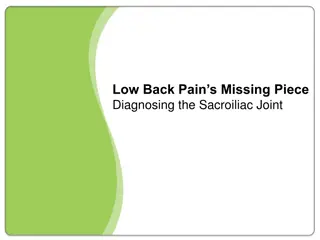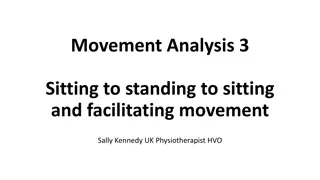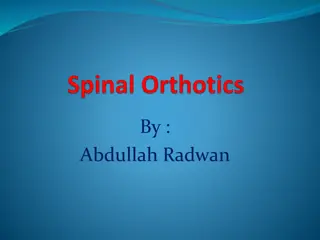
Understanding SI Joint Tests and Clinical Prediction Rules
Learn about the psychometric properties of SI joint special tests, the difference between movement palpation and pain provocation tests, and how clinical prediction rules can help evaluate the SI joint. Discover the reliability and diagnostic utility of various tests such as distraction, compression, and thigh thrust. Explore the sensitivity, specificity, positive likelihood ratio, and negative likelihood ratio of these tests as well.
Download Presentation

Please find below an Image/Link to download the presentation.
The content on the website is provided AS IS for your information and personal use only. It may not be sold, licensed, or shared on other websites without obtaining consent from the author. If you encounter any issues during the download, it is possible that the publisher has removed the file from their server.
You are allowed to download the files provided on this website for personal or commercial use, subject to the condition that they are used lawfully. All files are the property of their respective owners.
The content on the website is provided AS IS for your information and personal use only. It may not be sold, licensed, or shared on other websites without obtaining consent from the author.
E N D
Presentation Transcript
To become familiar with the psychometric properties of the SI joint special tests To understand the difference between movement palpation tests and pain provocation tests To understand clinical prediction rules and how to use them to evaluate the SI joint
Reliability: their results Sensitivity: someone with the pathology (SnOut: High sensitivity= Rule Out the Condition) Specificity: someone with the pathology (SpIn: High specificity: Rule In the Condition) Positive Likelihood Ratio (+LR): number, the more convincing that the finding suggests the condition Negative Likelihood Ratio ( number is to 0, the less likely the person has the condition Reliability: extent to which clinicians agree on Sensitivity: probability of a positive test result in Specificity: probability of a negative test result in Positive Likelihood Ratio (+LR): the larger the Negative Likelihood Ratio (- -LR): LR): the closer the Jewell, 2010
Poor diagnostic utility of motion palpation tests Broadhust et al. reported poor inter-test reliability in 11 out of 13 motion palpation tests that were used Less than 4 of rotation and up to 1.6 mm of translation at the pelvis Psychometric properties for motion palpation tests are low because of human s inability to detect this small amount of motion Broadhurst et al, 1998 Laslett, 2008
Distraction (Gapping) Compression Thigh Thrust (Femoral Shear) Gaenslen s Test FABER (Patrick s Test) Sacral Thrust
Reliability: 0.88-0.94 Sensitivity: 0.26-0.60 Specificity: 0.73-0.81 +LR: 3.20 -LR: 0.49 Kokmeyer et al, 2002 Laslett et al, 2005 Van der Wurff et al, 2006
Reliability: 0.79-0.93 Sensitivity: 0.60-0.69 Specificity: 0.69-0.70 +LR: 2.20 -LR: 0.46 Kokmeyer et al, 2002 Laslett et al, 2005 Van der Wurff et al, 2006
Reliability: 0.82-0.94 Sensitivity: 0.52-1.0 Specificity: 0.55-0.80 +LR: 0.72-4.07 -LR: 0.18-1.28 Kokmeyer et al, 2002 Laslett et al, 2005 Szadek et al, 2009
Reliability: 0.61-0.82 Sensitivity: 0.50-0.71 Specificity: 0.26-0.79 +LR: 2.21 -LR: 0.66 Kokmeyer et al, 2002 Laslett et al, 2005 Van der Wurff et al, 2006
Reliability: 0.85-0.96 Sensitivity: 0.63-1.0 Specificity: 0.16-0.77 +LR: 0.7 -LR: NR Kokmeyer et al, 2002 Van der Wurff et al, 2006 Szadek et al, 2009
Reliability: 0.66-0.78 Sensitivity: 0.51-0.63 Specificity: 0.29-0.75 +LR: 2.50 -LR: 0.50 Kokmeyer et al, 2002 Laslett et al, 2005 Szadek et al, 2009
Order of tests: Distraction, thigh thrust, compression, sacral thrust and Gaenslan s Distraction test is the most specific test Thigh thrust test is the most sensitive test Values based on a population of patients whose symptoms did not centralize or peripheralize on a McKenzie assessment Laslett et al, 2003
1 positive test 1 positive test 2 positive tests 2 positive tests 3 positive tests 3 positive tests 4 positive tests 4 positive tests 5 positive tests 5 positive tests Sensitivity 1.00 0.93 0.94 0.60 0.27 Specificity 0.44 0.66 0.78 0.81 0.88 When all of the provocation tests are negative, SIJ can be ruled out When all of the provocation tests are positive, SIJ can be ruled out 3 out of 5 positive tests has the strongest combination of psychometric properties Laslett et al, 2003
Tests: Distraction, thigh thrust, compression, FABER and Gaenslan s 3 out of 5 tests positive Sensitivity: 0.85 Specificity: 0.79 +LR: 4.02 Study used SIJ blocks as their gold standard for diagnosing SIJ dysfunction Van der Wurff et al, 2006
1 positive test 1 positive test 2 positive tests 2 positive tests 3 positive tests 3 positive tests 4 positive tests 4 positive tests 5 positive tests 5 positive tests Sensitivity 1.0 0.93 0.85 0.26 0.00 Specificity 0.42 0.58 0.79 0.82 1.0 +LR 1.74 2.18 4.02 1.43 0.00 Used a receiver operating characteristic (ROC) curve that expresses sensitivity against specificity; 3 positives resulted in the greatest area under the curve If 3 out of 5 tests are positive, the probability is between 65%-93% that the SIJ is the cause of the pain If <3 of 5 are positive, the probability is between 72%-99% that the SIJ is not the cause of the pain Van der Wurff et al, 2006
Movement palpation tests do not have strong diagnostic utility in the clinic because of human s inability to detect small amounts of movement at the pelvis Individual pain provocation tests do not have strong psychometric properties 3 out of 5 positive tests have the strongest diagnostic utility Distraction, thigh thrust, compression, sacral thrust and Gaenslan s (after using a McKenzie assessment to rule out likely disc pathology) Distraction, thigh thrust, compression, FABER and Gaenslan s
Broadhurst NA, Bond MJ. Pain provocation tests for the assessment of sacroiliac joint dysfunction. J Spinal Disord. 1998; 11(4):341-345. Jewell DV. Guide to Evidence Based Clinical Therapy Practice 2nd edition 2010. Jones and Bartlett, Sudbury, MA. Kokmeyer DJ, Van der Wurff P, Aufdemkampe G, Fickenscher TC. The reliability of multitest regimens with sacroiliac pain provocation tests. J Manipulative Physiol Ther. 2002; 25(1):42-48. Laslett M, Young SB, Aprill CN, McDonald B. Diagnosing painful sacroiliac joints: A validity study of a McKenzie evaluation and sacroiliac provocation tests. Aust J Physiother. 2003; 49(2):89-97. Laslett M, Aprill CN, McDonald B, Young SB. Diagnosis of sacroiliac joint pain: Validity of individual provocation tests and composites of tests. Man Ther. 2005; 10(3):207-218. Laslett M. Evidence-based diagnosis and treatment of the painful sacroiliac joint. J Man Manip Ther. 2008; 16(3):142-152. Szadek KM, van der Wurff P, van Tulder MW, Zuurmond WW, Perez RS. Diagnostic validity of criteria for sacroiliac joint pain: A systematic review. J Pain. 2009; 10(4):354-368. Van der Wurff P, Buijs EJ, Groen GJ. A multitest regimen of pain provocation tests as an aid to reduce unnecessary minimally invasive sacroiliac joint procedures. Arch Phys Med Rehabil. 2006; 87(1):10-14.






















